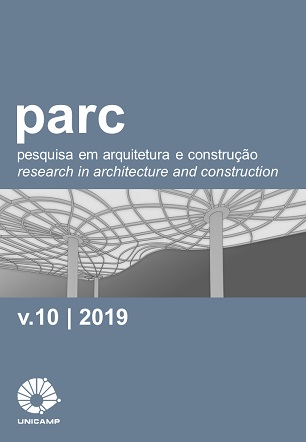Abstract
Despite the many advantages of integrating bioclimatic concepts into architectural design, studies show that for most architects their actual application is difficult. This indicates the existence of a gap between academic knowledge and design practice, especially concerning natural ventilation. Many of the natural ventilation strategies are presented employing visionary designs that do not represent their performance indoors. The objective of this research is to verify the materialization of basic principles of natural ventilation through a simplified method, aiming to facilitate the understanding of these phenomena by students during the teaching of natural ventilation in universities and, later, its application in the architectural design. The methodology was divided into three stages. 1. Construction of a flexible and simplified physical model for use in natural ventilation teaching; 2. Experimental tests in the proposed model, regarding the impact of the location of the openings on the performance of the indoor airflow in buildings; 3. Computational simulations based on computational fluid dynamics (CFD) of the same scenarios evaluated by the simplified method, in order to prove the efficiency of the proposed model for educational use in. The experimental and numerical results verified compatibility between the two tools, showing that it is possible to use this simplified model for understanding basic principles of natural ventilation such as, for example, the definition of the location of openings.
References
BLOCKEN, B.; STATHOPOULOS, T.; CARMELIET, J. CFD simulation of the atmospheric boundary layer: wall function problems. Atmospheric Environment, v. 41, n.2, p. 238-252, 2007. DOI: https://doi.org/10.1016/j.atmosenv.2006.08.019
BRANDÃO, R. S. As interações espaciais urbanas e o clima. 2009. Tese (Doutorado em Arquitetura e Urbanismo) – Faculdade de Arquitetura e Urbanismo, Universidade de São Paulo, São Paulo, 2009.
CÂNDIDO, C.; DEAR, R. J. de; LAMBERTS, R.; BITTENCOURT, L. Air movement acceptability limits and thermal comfort in Brazil’s hot humid climate zone. Building and environment, v. 45, p. 222-229, jan. 2010. DOI: https://doi.org/10.1016/j.buildenv.2009.06.005
COST. Cost Action 14: recommendations on the use of CFD in predicting pedestrian wind environment. Bruxelas: Cost, 2004.
COSTA, L. Aproveitamento da ventilação natural nas habitações: um estudo de caso na cidade de Aracaju – SE. Dissertação (Mestrado em Tecnologia da Arquitetura) – Faculdade de Arquitetura e Urbanismo, Universidade de São Paulo, São Paulo, 2009.
CÓSTOLA, D. Ventilação por ação do vento no edifício: procedimentos para quantificação. Dissertação (Mestrado em Tecnologia da Construção) – Faculdade de Arquitetura e Urbanismo, Universidade de São Paulo, São Paulo, 2006.
CÓSTOLA, D.; ALUCCI, M. Pressure coefficient simulated by CFD for wind-driven ventilation analysis. Proceedings Building Simulation, Beijing, China, 2007.
EDWARDS, B.; HYETT, P. Guía básica de la sostenibilidad. Barcelona, G. Gilli, 3° edição, 2005.
FIGUEIREDO, C. A. Ventilação natural em edifícios de escritórios na cidade de São Paulo: limites e possibilidades do ponto de vista do conforto térmico. Dissertação (Mestrado em Tecnologia da Construção) – Faculdade de Arquitetura e Urbanismo da Universidade de São Paulo, São Paulo, 2007.
HARRIES, A. Notas de aula. In: Workshop: CFX – FAU/USP. São Paulo, 2005.
KOWALTOWSKI, D. C. C. K.; LABAKI, L. C.; PINA, S. M. G.; BERTOLLI, S. R. A visualização do conforto ambiental no projeto arquitetônico. In: ENCONTRO DE TECNOLOGIA DO AMBIENTE CONSTRUÍDO E QUALIDADE NO PROCESSO CONSTRUTIVO, 7., 1998, Florianópolis. Anais [...]. Porto Alegre: ANTAC, 1998. p. 371-379.
KOWALTOWSKI, D. C. C. K.; CELANI, M. G. C.; MOREIRA, D. C.; PINA, S. A. M. G.; RUSCHEL, R. C.; DA SILVA, V. G.; LABAKI, L. C.; PETRECHE, J. R. D. Reflexão sobre metodologias de projeto arquitetônico. Revista ambiente construído, v. 6, n. 2, p. 07-19, 2006.
LABAKI, L. C.; MATSUMOTO, E. CARAM, R. M. Túnel de vento de camada limite atmosférica: calibração e ensaios de aberturas em edificações utilizando modelos reduzidos. Relatório de projeto de pesquisa, 2012
LAMBERTS, R.; DUTRA, L.; PEREIRA, F. O. R. Eficiência energética na Arquitetura. 3º edição. São Paulo: ProLivros, 2014.
LEITE, C. G. Alterações da ventilação urbana frente ao processo de verticalização de avenidas litorâneas: o caso da avenida litorânea de São Luís/MA. Dissertação (Mestrado em Arquitetura e Urbanismo) – Faculdade de Arquitetura e Urbanismo. Universidade de São Paulo, São Paulo, 2008.
LÔBO, D. G. F.; BITTENCOURT, L. S. A influência dos captadores de vento na ventilação natural de habitações populares localizadas em climas quentes e úmidos. Ambiente Construído, Porto Alegre, v. 3, n. 2, p. 57-67, 2003.
LUKIANTCHUKI, M. A. A evolução das estratégias de conforto térmico e ventilação natural na obra de João Filgueiras Lima, Lelé: Hospitais Sarah de Salvador e do Rio de Janeiro. Dissertação (mestrado) – Escola de Engenharia de São Carlos, Universidade de São Paulo, São Carlos, 2010.
MACIEL, A. A. Integração de conceitos bioclimáticos ao projeto arquitetônico. Tese (Doutorado em Arquitetura e Urbanismo) - Universidade Federal de Santa Catarina, Florianópolis, 2006.
PRATA, A. R. Impacto da altura de edifícios nas condições de ventilação natural no meio urbano. Tese (Doutorado em Arquitetura e Urbanismo) – Faculdade de Arquitetura e Urbanismo, Universidade de São Paulo, São Paulo, 2005.
RAMPONI, R.; BLOCKEN, B. Simulation of cross-ventilation for a generic isolated building: impact of computational parameters. Building and environment, v. 53, p. 34-48, jul. 2012. DOI: https://doi.org/10.1016/j.buildenv.2012.01.004
TREBILCOCK, M. (2007). The integration of environmental sustainability issues in the design process of contemporary architectural practice. Tese de doutorado, University of Nottingham, 2007.
TRINDADE, S. C.; PEDRINI, A.; DUARTE, R. N. C. Métodos de aplicação da simulação computacional em edifícios naturalmente ventilados no clima quente e úmido. Revista do ambiente construído, v. 10, n. 4, p. 37-58, 2010.
I accept that PARC Research in Architecture and Building Construction journal perform, on the original file approved for publication, revisions and modifications in orthoghaphic, grammar and standard issues.
I give to PARC Research in Architecture and Building Construction journal the rights of first publication of the revised version of my paper, licensed under the 'Creative Commons Attribution' license (which allows sharing the work with the recognition of first authorship and publication in this journal).


